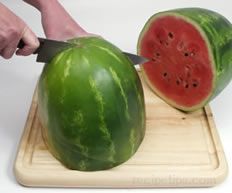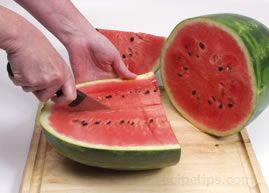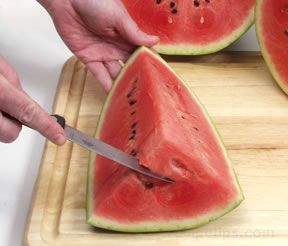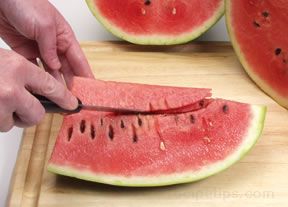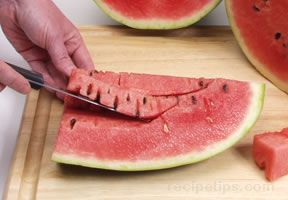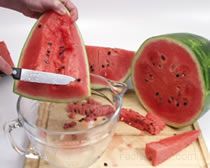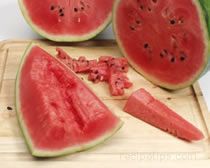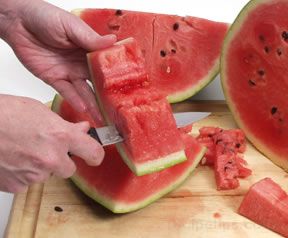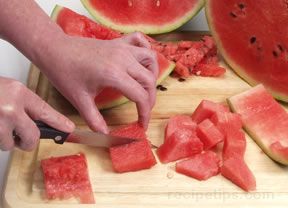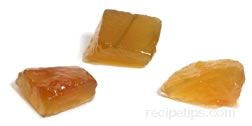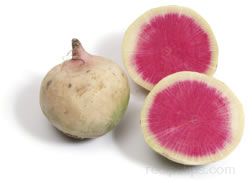|
Cutting Watermelon | Removing Watermelon Seeds | Tips
| Watermelon |

A popular fruit that grows on ground vines in a number of different shapes and sizes, all round and fairly large. Watermelons can range in shape from round to elongated, weigh from 8 to 30 pounds and be filled with seeds or seedless. They have a thick rind that surrounds a range of flesh colors from pink to dark red and yellow. Some of the common types of melons are allsweet, crimson sweet, icebox, jubilee, seedless, and yellow flesh. The icebox melon is round in shape, weighs from 5 to 15 pounds, and contains a red or yellow flesh. The jubilee and allsweet varieties are oval-shaped and elongated, larger in size (25 to 45 pounds), with flesh that can be pink to dark red. The Crimson sweets weigh between 15 to 35 pounds, have a shape that can be round or elongated, and have a flesh that can be either yellow or red. Yellow flesh melons generally weigh from 10 to 30 pounds, with a round or oval shape, and contain a bright yellow flesh that is not as sweet as the red-fleshed variety. The seedless watermelons are very popular due to their lack of seeds. They range in size from 10 to 25 pounds and have a flesh color that can be either red or yellow. All watermelons consist of 80 to 90% water, they are low in calories, and contain an airy flesh that is very juicy and sweet to the taste. |
|
Uses:
Watermelon is most often eaten on its own. It is sliced, quartered, cubed, or scooped to form balls. It is added to fruit salad and used to make jam, sorbet, juice, salsa, and sometimes wine. Watermelon that has not yet ripened is used in the same way as summer squash.
The seeds of a watermelon can be eaten. They are roasted, and/or salted and sometimes ground into a form of cereal to make bread.
The watermelon rind can be candied or marinated. |
|
How to Buy:
It is difficult to determine whether a watermelon is flavorful without cutting it open and tasting it. Select watermelons that are firm, free of bruises, and heavy. Ripe melons generally have a nice sheen to their outer skin and a yellow spot on their underside, which remains from where the melon grew on the ground.
When purchasing a precut watermelon, select a watermelon with flesh that is firm, juicy, bright in color and has no visible white streaks. |
Storage:
- If uncut watermelon needs to ripen, store at room temperature.
- Watermelon that has ripened but has not been cut should be refrigerated. Uncut, ripe watermelon keeps longer and is more refreshing to eat when chilled.
- Watermelon that has been cut should be wrapped tightly in plastic wrap or placed in an airtight container. This will keep the cut watermelon from absorbing the odors of other foods and prevent it from drying out. Eat as soon as possible.
|
| FYI…Because it contains vitamin C and potassium, watermelon is thought to be a great detoxifier, diuretic, and cleansing agent. |
| FACT: Watermelons originated in Africa and are now grown all over the world. There are hundreds of varieties and while it may be thought of as a fruit, it is actually a vegetable related to the cucumber family. |
How to cut a Watermelon into Cubes
|
Wash your hands before you begin. Wash the watermelon under cold water, using a kitchen brush to remove any excess dirt.
Always use a sharp kitchen knife and a secure cutting surface when preparing watermelon.
To cut watermelon into cubes, begin by removing both ends of the watermelon. Stand the watermelon vertically on the cutting surface. |
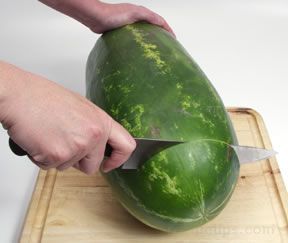 |
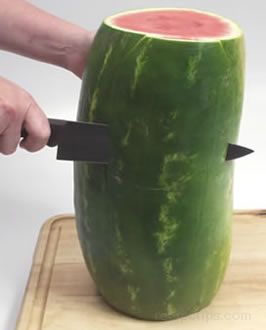 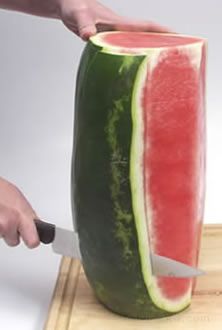 |
| Choose a side and begin to slice the rind off, following through by slicing all the way to the opposite end of the watermelon. The first slice of rind tends to remove more watermelon flesh than the remaining slices of rind will. Continue until all of the rind has been removed. |
|
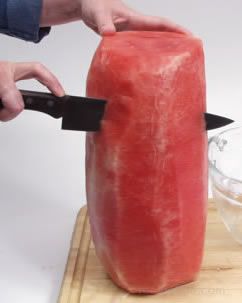 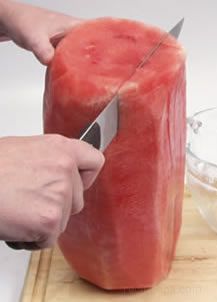
|
| Make 4-6 even, vertical slices across the watermelon, stopping halfway through. Now make 4-6 even, vertical slices, crossing the previous slices, halfway down the watermelon. This will form a pattern of squares on the top of the watermelon. |
| Once you have created a criss-cross pattern halfway through the watermelon, slice the watermelon horizontally to create the cubed pieces. Continue down the watermelon until you reach the halfway point. You will then need to repeat the process with the remaining watermelon, this time slicing to approximately 2-inches from the bottom of the watermelon. |
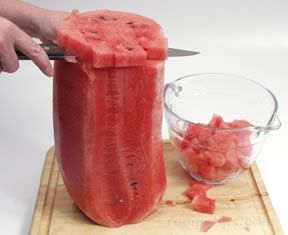 |
Removing Seeds from a Watermelon
Tips
- If a whole watermelon is to large to fit in the refrigerator, store in a cool dark area for up to 4 days.
- Cut watermelon in half lengthwise, scoop the watermelon out of one half, cut edges into scallops, and use the scooped out rind for a decorative bowl to serve a fresh fruit salad.
|












